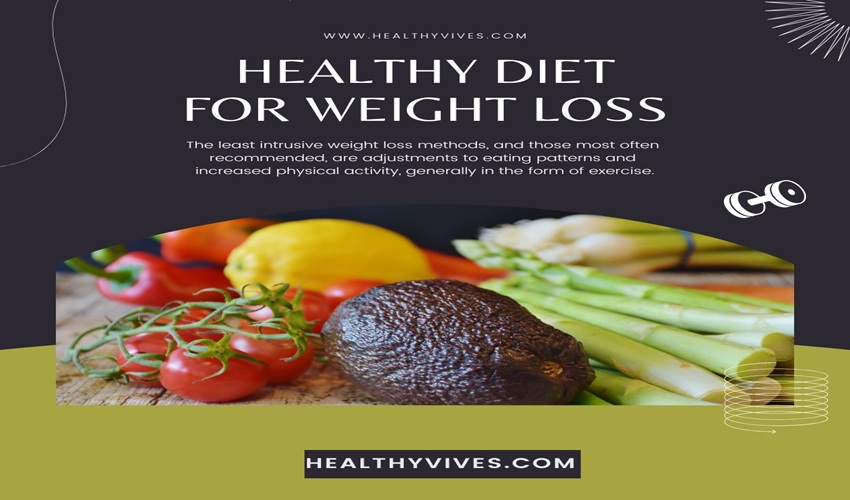
Maintaining a Healthy eating for weight loss is essential for achieving and sustaining weight loss. It supplies the body with vital nutrients necessary for optimal functioning and significantly influences metabolism and appetite regulation. Embracing a nutritious eating plan can facilitate the creation of a caloric deficit while ensuring that you remain satisfied and energized throughout the day. In contrast to the tempting quick fixes and fad diets that often promise rapid weight loss but yield only temporary results, healthy eating emphasizes long-term lifestyle modifications that encourage sustainable weight management.
Numerous misconceptions exist regarding dieting. Many people believe that severe calorie restriction or the complete elimination of certain food groups is the most effective method for weight loss. However, such strategies can result in nutrient deficiencies, episodes of binge eating, and an unhealthy relationship with food. In truth, successful weight loss is more about making educated food choices that align with your objectives while nourishing your body, rather than about deprivation.
This article aims to present practical and sustainable eating strategies that can facilitate effective weight loss. By concentrating on whole, nutrient-rich foods, practicing portion control, and fostering a positive relationship with food, you can establish a balanced eating approach that not only aids in weight loss but also improves your overall health and well-being.
Best Guide to Healthy Eating for Weight Loss
To initiate a successful weight loss endeavor, it is imperative to grasp the essential elements of nutrition, which include macronutrients, micronutrients, and the significance of caloric intake.
Macronutrients
Macronutrients are the nutrients that the body requires in substantial quantities to provide the energy necessary for its functions. There are three main categories of macronutrients:
Carbohydrates: Carbohydrates serve as the primary energy source for the body. They are present in various foods such as fruits, vegetables, grains, and legumes. Carbohydrates can be divided into simple sugars (such as glucose and fructose) and complex carbohydrates (including starches and fiber). While they are vital for supporting daily activities and exercise, it is important to select the appropriate types of carbohydrates. Emphasize whole grains, fruits, and vegetables, which are rich in fiber and nutrients, rather than refined sugars and processed foods that may lead to weight gain and energy fluctuations.
Proteins: Proteins are crucial for the construction and repair of tissues, including muscles, and are necessary for hormone synthesis and immune system functionality. They are made up of amino acids, some of which are essential and must be sourced from the diet. Lean protein options include chicken, turkey, fish, beans, lentils, tofu, and low-fat dairy products. Adequate protein intake can also promote satiety and assist in preserving muscle mass during weight loss.
Fats: Fats are vital for hormone production, nutrient absorption, and serving as a concentrated energy source. Although fats have often been vilified in various diets, healthy fats are essential for overall well-being. Sources of beneficial fats include avocados, nuts, seeds, olive oil, and fatty fish such as salmon. It is crucial to distinguish between healthy unsaturated fats and unhealthy saturated and trans fats, which can lead to weight gain and health complications when consumed excessively.
Emphasize Whole Foods
Emphasizing whole foods is among the most effective approaches to facilitate weight loss and improve overall health. To begin, it is essential to comprehend the definition of whole foods and how they contrast with processed foods.

Definition of Whole Foods vs. Processed Foods
Whole Foods: Whole foods refer to items that are minimally processed or refined and do not contain artificial substances or additives. They exist in their natural form or have undergone slight processing, which aids in preserving their inherent nutrients. Examples of whole foods include fresh fruits, vegetables, whole grains, nuts, seeds, lean meats, fish, eggs, and legumes.
Processed Foods: Conversely, processed foods are those that have been modified in some manner during preparation, often to improve flavor, extend shelf life, or enhance convenience. These foods frequently include added sugars, unhealthy fats, sodium, and artificial components. Common examples encompass sugary snacks, fast food, sugary drinks, and pre-packaged meals. While not all processed foods are detrimental to health, many tend to be high in calories and low in nutrients, contributing to weight gain and various health concerns.
Advantages of Whole Foods
Nutrient Density: Whole foods are generally abundant in essential nutrients, such as vitamins, minerals, antioxidants, and fiber. These nutrients support numerous bodily functions and contribute to overall well-being. The high nutrient density of whole foods allows for the intake of more vitamins and minerals with fewer calories, making them an ideal option for weight loss.
Reduced Caloric Content: Whole foods typically possess a lower caloric content compared to processed foods. This characteristic enables individuals to consume larger portions while still achieving a caloric deficit, which is vital for weight loss. For instance, one can enjoy a substantial serving of fresh vegetables or fruits without a significant caloric intake, aiding in prolonged feelings of fullness.
Enhanced Satiety: Whole foods often contain fiber, which promotes a sense of fullness and assists in appetite regulation.

Emphasize Portion Control
Emphasizing portion control is a crucial element of nutritious eating that can greatly influence weight loss endeavors. Recognizing appropriate serving sizes and being conscious of calorie consumption aids in preventing overeating while still allowing for a diverse diet. Below is an explanation of the significance of portion control and strategies for effectively incorporating it into your everyday life.
Significance of Recognizing Serving Sizes and Caloric Consumption
Recognizing serving sizes is essential for regulating caloric intake. Many individuals tend to underestimate their food consumption, resulting in excessive calorie intake even when consuming healthier options. By familiarizing yourself with standard serving sizes, you can make more educated choices regarding what and how much to eat. This knowledge enables you to savor your preferred foods while sustaining a calorie deficit, which is vital for weight loss.
Monitoring your caloric intake can also prove advantageous. While it is not necessary to meticulously count calories, being aware of the caloric content of various foods can assist you in making healthier selections. This awareness can steer you towards more nutrient-rich options and away from those laden with empty calories.
Strategies for Portion Control
Utilize Smaller Dishware: A practical method for managing portions is to opt for smaller plates and bowls. This minor adjustment can create the perception of a fuller plate, helping you feel content with smaller quantities of food. Studies have indicated that individuals tend to consume less when serving themselves on smaller dishware.
Measure Your Portions: Employing measuring cups or a food scale can offer a precise understanding of serving sizes. This approach can be particularly beneficial when familiarizing yourself with what constitutes a standard portion, especially for items such as pasta, grains, and nuts, which are often easy to overindulge in.
Pre-portion Your Snacks: Rather than consuming snacks directly from their packaging, consider pre-portioning them into smaller containers or bags. This method helps to mitigate mindless eating and keeps you conscious of your consumption levels.
Increase Your Intake of Fruits and Vegetables
Enhancing your diet with a greater variety of fruits and vegetables is among the most effective methods for facilitating weight loss and enhancing overall health. These foods, rich in nutrients, are low in calories and high in fiber, making them a vital part of any weight loss strategy.
Advantages of Fruits and Vegetables for Weight Management
High in Fiber: Fruits and vegetables serve as excellent sources of dietary fiber, which is essential for weight management. Fiber aids in regulating digestion, fosters a sense of fullness, and slows the absorption of sugars into the bloodstream. This can help mitigate blood sugar spikes and diminish cravings, thereby making appetite control more manageable.
Low in Calories: The majority of fruits and vegetables are low in calories, enabling you to consume larger portions without surpassing your caloric requirements. This allows for a satisfying volume of food while still achieving the caloric deficit necessary for weight loss.
Nutrient-Dense: Fruits and vegetables are abundant in vitamins, minerals, and antioxidants that contribute to overall health and wellness. These nutrients are crucial for energy production, immune system support, and lowering the risk of chronic illnesses.
Strategies for Incorporating More Produce into Your Meals and Snacks
Plan Your Meals: Make it a point to include fruits and vegetables in your meal planning. Strive to have at least one serving of produce with each meal and snack. This practice will ensure that healthy options are readily available and encourage you to try various types.
Keep Produce Accessible: Store fruits and vegetables in easily accessible locations, such as the front of your refrigerator or on the countertop. When these items are more visible, you are more likely to choose them over less nutritious alternatives.
Enhance Meals with Vegetables: Increase the vegetable content in the dishes you already prepare. For example, consider adding spinach or kale to omelets, incorporating bell peppers or zucchini into stir-fries, or blending vegetables into sauces and soups.
opt for Lean Proteins
Selecting lean proteins is an essential approach for successful weight loss and overall well-being. Protein serves multiple vital functions in the body, and recognizing its advantages can assist you in making educated dietary decisions.
Significance of Protein in Weight Management
Satiety: A key reason to include lean protein in your diet is its capacity to enhance feelings of fullness. Protein is digested more slowly than carbohydrates, which can help you feel satisfied for extended periods. This can diminish the desire to snack between meals and aid in managing your calorie consumption.
Muscle Preservation: During weight loss, it is crucial to maintain muscle mass. A protein-rich diet can help safeguard against muscle loss while on a calorie-restricted plan. This is particularly important, as preserving muscle mass can keep your metabolism functioning efficiently, enabling your body to burn more calories even at rest.
Thermogenic Effect: Protein exhibits a greater thermogenic effect than fats and carbohydrates, meaning that your body expends more calories in the process of digesting and metabolizing protein. This can further facilitate weight loss when paired with a balanced diet and consistent physical activity.
Illustrations of Lean Protein Sources
Chicken: Skinless chicken breast is among the most favored lean protein choices. It is adaptable and can be grilled, baked, or incorporated into salads and stir-fries.
Fish: Fish, especially types such as salmon, tuna, and cod, are outstanding sources of lean protein. Additionally, fish provides beneficial omega-3 fatty acids, which support heart health.
Beans and Legumes: Beans (including black beans, kidney beans, and lentils) are excellent plant-based protein options. They are also rich in fiber, which aids in promoting satiety and supporting digestive health.
Tofu and Tempeh: Tofu and tempeh serve as excellent protein sources for those following vegetarian or vegan diets. Tofu is highly versatile and can be utilized in stir-fries, soups, or salads, while tempeh offers a firmer texture and a nutty flavor, making it an excellent meat alternative.
Minimize Added Sugars and Refined Carbohydrates
Minimizing the intake of added sugars and refined carbohydrates is an essential approach for successful weight loss and enhancing overall health. These components are frequently present in processed foods and can contribute to weight gain and a range of health complications when consumed in large quantities.
Understanding the Impact of Added Sugars and Refined Carbs on Weight Gain
High-Caloric Content: Added sugars and refined carbohydrates are characterized by their high caloric content while lacking essential nutrients. Foods rich in these substances typically offer minimal vitamins, minerals, and fiber, yet significantly increase total caloric consumption. This nutritional imbalance can result in weight gain when such foods are regularly included in the diet.
Rapid Blood Sugar Fluctuations: The body quickly metabolizes added sugars and refined carbohydrates, leading to swift increases in blood sugar levels. This phenomenon can trigger an initial burst of energy, followed by a subsequent drop, which often results in heightened cravings for additional sugary or carbohydrate-rich foods. This repetitive cycle can promote overeating and subsequent weight gain.
Enhanced Fat Accumulation: An excessive intake of sugar, particularly fructose (commonly found in many sweetened drinks and snacks), can result in increased fat accumulation in the liver and other tissues. This accumulation may lead to insulin resistance, metabolic syndrome, and various other health concerns, complicating weight management efforts.
Methods for Decreasing Sugar Consumption
Examine Food Labels: Familiarizing oneself with food labels can aid in recognizing added sugars in packaged products. Look for ingredients such as high fructose corn syrup, cane sugar, and various syrups. Strive to select items with minimal to no added sugars, particularly for products like sauces, dressings, and snacks.
Opt for Whole Grains: When choosing grains, prefer whole grains over refined varieties. Whole grains such as brown rice, quinoa, and whole-grain bread maintain their fiber and nutrients, which can assist in stabilizing blood sugar levels and enhancing satiety.
Reduce Sugary Drinks: Soft drinks, energy drinks, and sweetened teas can be significant sources of added sugars.

Maintain Adequate Hydration
Maintaining adequate hydration is frequently underestimated in the quest for weight loss; however, it is a vital component of effective weight management and overall well-being. Sufficient hydration can affect metabolism, appetite regulation, and energy levels, making it an indispensable element of any weight loss plan.
Significance of Hydration in Weight Management
Metabolic Enhancement: Water is essential for numerous metabolic functions within the body, such as digestion and nutrient assimilation. Ensuring proper hydration allows your body to efficiently transform food into energy, thereby supporting weight loss initiatives.
Appetite Regulation: Often, dehydration is misinterpreted as hunger. Consuming an adequate amount of water throughout the day can help mitigate unnecessary snacking by fostering a sense of fullness. Research indicates that drinking water prior to meals can result in decreased calorie consumption, facilitating weight loss.
Energy Maintenance: Lack of hydration can lead to tiredness, which may diminish your willingness to engage in physical activity. Proper hydration is crucial for sustaining energy levels, allowing you to participate in exercises and workouts that are vital for weight loss.
Function of Water in Metabolism and Appetite Regulation
Thermogenic Effect: Consuming cold water may provide a temporary increase in your metabolism, as your body uses energy to warm the water to its normal temperature. While this effect is modest, it contributes to overall calorie expenditure.
Signals of Satiety: Adequate water intake can help trigger satiety signals, leading to a quicker sense of fullness. This is particularly advantageous during meals, as it can decrease the chances of overeating.
In summary, maintaining proper hydration is a crucial aspect of successful weight management. Recognizing the significance of water in regulating metabolism and appetite, along with adopting straightforward methods to boost your water consumption, can aid in your weight loss endeavors while promoting your overall health and wellness. Prioritizing hydration will enable you to feel your optimal self and sustain your energy throughout your weight loss journey.
Organize and Prepare Meals in Advance
Meal organization and preparation serve as effective strategies for achieving and sustaining a healthy diet, especially when the goal is weight loss. By arranging your meals beforehand, you can make more nutritious choices, conserve time, and diminish the chances of impulsive eating.
Advantages of Meal Organization and Preparation for Healthy Eating
Control Over Ingredients: By planning your meals, you can select whole, nutrient-rich foods while steering clear of processed items that may contain excessive added sugars, unhealthy fats, and empty calories. This oversight of ingredients can foster healthier eating habits and enhance nutritional quality.
Time and Stress Management: Preparing meals in advance can significantly reduce the time spent during hectic weekdays. With meals ready to eat, you can alleviate the pressure of last-minute cooking and the temptation to resort to unhealthy convenience foods.
Portion Management: Meal preparation promotes portion control, which is vital for regulating calorie intake. By pre-portioning your meals and snacks, you can more effectively manage your food consumption, facilitating adherence to your weight loss objectives.
Enhanced Accountability: A structured meal plan can bolster your commitment to dietary goals. Knowing in advance what you will eat reduces the likelihood of deviating from your plan and indulging in unhealthy options.
Methods for Efficient Meal Preparation
Batch Cooking: A highly effective meal preparation technique is batch cooking, where you prepare large quantities of food simultaneously. Designate a specific day each week to cook staples such as grains (quinoa, brown rice), proteins (chicken, tofu, beans), and roasted vegetables. Store these in individual containers to simplify meal assembly.
Weekly Menu Planning: Dedicate some time each week to outline your meals. Take into account your schedule and select recipes that align with your lifestyle. A well-defined menu can streamline your grocery shopping and ensure you have all necessary ingredients readily available.
In conclusion, the practice of planning and preparing meals in advance is an essential approach for upholding a nutritious diet and facilitating weight loss objectives. By managing your food selections, alleviating stress, and guaranteeing the availability of healthy options, you can implement lasting modifications to your dietary habits. With some dedication and systematic organization, meal preparation can contribute to a healthier lifestyle and enduring success in your weight management efforts.
Conclusion
In summary, implementing healthy eating practices is crucial for effective weight loss and the maintenance of overall health. This article has examined a range of practical strategies aimed at helping you develop healthier eating patterns that facilitate weight loss while nourishing your body.
Recap of the Essential Healthy Eating Practices for Weight Loss
Grasping Nutritional Fundamentals: A comprehensive understanding of macronutrients and micronutrients is vital for making informed dietary choices. Emphasizing balanced meals that incorporate carbohydrates, proteins, and fats, along with necessary vitamins and minerals, is essential for optimal health.
Prioritizing Whole Foods: Opting for whole, minimally processed foods instead of refined alternatives ensures that you consume meals rich in nutrients that aid in weight loss while supplying your body with essential nutrients.
Implementing Portion Control: Recognizing appropriate serving sizes and utilizing techniques such as smaller plates can assist in managing calorie consumption and minimizing the risk of overeating.
Increasing Fruit and Vegetable Intake: These foods are low in calories but high in fiber and nutrients, making them excellent choices for satisfying meals and snacks that support weight loss.
Selecting Lean Proteins: Protein plays a critical role in promoting satiety and preserving muscle mass, making it a key element of a weight loss diet. Incorporating a variety of lean protein sources can enhance feelings of fullness and satisfaction.
Minimizing Added Sugars and Refined Carbohydrates: Reducing these components can help stabilize blood sugar levels, decrease cravings, and encourage healthier eating behaviors.
Maintaining Hydration: Adequate hydration is essential for metabolic function and appetite regulation. Choosing water as your primary beverage can aid in achieving weight loss objectives and enhancing overall health.
Meal Planning and Preparation: Organizing meals in advance allows for better control over ingredients and portion sizes, while also saving time and reducing stress, all of which contribute to healthier eating decisions.
By adopting Healthy eating for weight loss these strategies and prioritizing sustainable, nutritious eating practices, you can reach your weight loss objectives while improving your overall health. It is important to recognize that this is a lifelong endeavor—approach it with optimism, adaptability, and a dedication to your personal well-being. This holistic method will not only facilitate weight loss but also foster a more joyful and healthier lifestyle for the long term.

